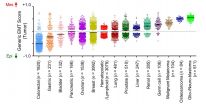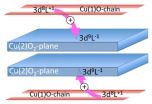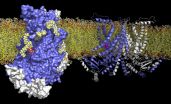INFORMATION:
Additional researchers on this project are Elizabeth B. Neely, research associate; and Zachary Simmons, M.D., professor of neurology, all at Penn State College of Medicine.
The Judith and Jean Pape Adams Charitable Foundation, the Paul and Harriett Campbell Fund for ALS Research, Zimmerman Family Love Fund and the Robert Luongo ALS Fund supported this research.
Genotype found in 30 percent of ALS patients speeds up disease progression
2014-11-13
(Press-News.org) Mice bred to carry a gene variant found in a third of ALS patients have a faster disease progression and die sooner than mice with the standard genetic model of the disease, according to Penn State College of Medicine researchers. Understanding the molecular pathway of this accelerated model could lead to more successful drug trials for all ALS patients.
Amyotrophic lateral sclerosis, commonly known as Lou Gehrig's disease, is a degeneration of lower and upper motor neurons in the brainstem, spinal cord and the motor cortex. The disease, which affects 12,000 Americans, leads to loss of muscle control. People with ALS typically die of respiratory failure when the muscles that control breathing fail.
Penn State researchers were the first to discover increased iron levels in the brains of some patients with the late-onset neurodegenerative disorders Parkinson's disease and Alzheimer's disease. A decade ago, they also identified a relationship between ALS and excess iron accumulation when they found that 30 percent of ALS patients in their clinic carried a variant of a gene known as HFE that is associated with iron overload disease.
For this study, the researchers crossbred mice with the HFE gene variant with the standard mice used in ALS research.
"When we followed the disease progression and the behavior of our crossbred mice compared to the standard mice, we saw significant differences," said James Connor, vice chair of neurosurgery research and director of the Center for Aging and Neurodegenerative Diseases. The crossbred mice performed significantly worse on tests of forelimb and hindlimb grip strength and had a 4 percent shorter life span. The researchers published their findings in BBA Molecular Basis of Disease.
"The disease progression was much faster in the crossbred mice than in the standard mice," Connor said. "What we found is that when ALS happens in the presence of the HFE gene variant, things go downhill more quickly."
The lead investigator on this project, graduate student Wint Nandar, noticed that the HFE gene variant sped up disease progression and death in females but not males. Males with ALS die faster, on average, than females.
Connor said the variant may not have had time to accelerate the pace of the disease in male mice. An accelerated progression may show up in clinical trials in human males, who live longer with the disease than mice.
The researchers also studied how the HFE gene modified the pace of the disease in mice. The crossbred mice showed increased oxidative stress and microglial activation. Microglial cells normally help with repair in the body, but when over-activated they can promote unhealthy inflammation.
"They can make things worse instead of better," Connor said.
The mice were also found to have disruption of the neurofilaments, the tiny cables that transport nutrients through nerve cells.
"It's a much worse environment when the gene variant is present," Connor said. "This makes it much easier for the disease to take off."
The findings could help direct more successful clinical testing of new drug treatments, which have traditionally had disappointing results. Because patients with H63D HFE have an accelerated form of the disease, their results could skew study findings.
"There might be drugs out there that work for 70 percent of the ALS population even though the studies don't show that when all of the data are looked at without consideration of the genetic background," Connor said.
Separating the data out could help find effective treatments for both those with the gene variant and the rest of the ALS population.
"How a drug is going to work on a carrier of the gene variant could be worse or it could be better, but it's likely going to be different," Connor said.
ELSE PRESS RELEASES FROM THIS DATE:
Legally prescribed opioid use may increase mortality in chronic pain patients
2014-11-13
Philadelphia, November 13, 2014 - Associations between opioid-related overdoses and increased prescription of opioids for chronic noncancer pain are well known. But some suggest that overdose occurs predominately in individuals who obtain opioids from nonmedical sources. In a new study published in the November issue of the journal PAIN®, researchers in Denmark found an increased risk of death associated with chronic pain without opioid treatment, as well as an even higher risk among those prescribed opioids for long-term use and a somewhat lower risk associated with ...
Scientists develop scoring scheme that predicts ability of cancer cells to spread
2014-11-13
Scientists at the Cancer Science Institute of Singapore (CSI Singapore) at the National University of Singapore (NUS) and their collaborators have developed a scoring scheme that predicts the ability of cancer cells to spread to other parts of the body, a process known as metastasis. This system, which is the first of its kind, opens up the possibility to explore new treatments that suppress metastasis in cancer patients. The findings were published in EMBO Molecular Medicine in September.
Led by Professor Jean Paul Thiery, Senior Principal Investigator, and Dr Ruby Huang, ...
Self-doping may be the key to superconductivity in room temperature
2014-11-13
Swedish materials researchers at Linköping and Uppsala University and Chalmers University of Technology, in collaboration with researchers at the Swiss Synchrotron Light Source (SLS) in Switzerland investigated the superconductor YBa2Cu3O7-x (abbreviated YBCO) using advanced X-ray spectroscopy.
Their findings are published in the Nature journal Science Reports.
YBCO is a well-known ceramic copper-based material that can conduct electricity without loss (superconductivity) when it is cooled below its critical temperature Tc=-183° C. Since the resistance and ...
Facial motion a clue to difficulties in social interaction among autistic adults
2014-11-13
People on the autistic spectrum may struggle to recognise social cues, unfamiliar people or even someone's gender because of an inability to interpret changing facial expressions, new research has found.
According to the study by academics at Brunel University London, adults with autism spectrum disorders (ASD), though able to recognise static faces, struggle with tasks that require them to discriminate between sequences of facial motion or to use facial motion as a cue to identity.
The research supports previous evidence to suggest that impairments in perceiving biological ...
Architecture of a lipid transport protein revealed
2014-11-13
Membranes are thin walls that surround cells and protect their interior from the environment. These walls are composed of phospholipids, which, due to their amphiphilic nature, form bilayers with dis-tinct chemical properties: While the outward-facing headgroups are charged, the core of the bilayer is hydrophobic, which prevents charged molecules from passing through. The controlled flow of ions across the membrane, which is essential for the transmission of nerve impulses, is facilitated by ion channels, membrane proteins that provide gated pathways for ions. Analogous ...
Cats and athletes teach robots to fall
2014-11-13
A cat always lands on its feet. At least, that's how the adage goes. Karen Liu hopes that in the future, this will be true of robots as well.
To understand the way feline or human behavior during falls might be applied to robot landings, Liu, an associate professor in the School of Interactive Computing (IC) at Georgia Tech, delved into the physics of everything from falling cats to the mid-air orientation of divers and astronauts.
In research presented at the 2014 IEE/RSJ International Conference on Intelligent Robots and Systems (IROS), Liu shared her studies of mid-air ...
Mars, too, has macroweather
2014-11-13
Weather, which changes day-to-day due to constant fluctuations in the atmosphere, and climate, which varies over decades, are familiar. More recently, a third regime, called "macroweather," has been used to describe the relatively stable regime between weather and climate.
A new study by researchers at McGill University and UCL finds that this same three-part pattern applies to atmospheric conditions on Mars. The results, published in Geophysical Research Letters, also show that the sun plays a major role in determining macroweather.
The research promises to advance ...
Effectiveness of innovative gene therapy treatment demonstrated in canine model of DMD
2014-11-13
Duchenne muscular dystrophy is the most common neuromuscular disease of children (affecting 1 boy in 3500-5000 births). It is caused by a genetic defect in the DMD gene residing on the X chromosome, which results in the absence of the dystrophin protein essential to the proper functioning of muscles.
The treatment being developed by researchers at Atlantic Gene Therapies, Généthon and the Institute of Myology, is based on the use of an AAV vector (Adeno Associated Virus) carrying a transgene for the skipping of a specific exon which allows functional dystrophin ...
New process isolates promising material
2014-11-13
After graphene was first produced in the lab in 2004, thousands of laboratories began developing graphene products worldwide. Researchers were amazed by its lightweight and ultra-strong properties. Ten years later, scientists now search for other materials that have the same level of potential.
"We continue to work with graphene, and there are some applications where it works very well," said Mark Hersam, the Bette and Neison Harris Chair in Teaching Excellence at Northwestern University's McCormick School of Engineering and Applied Science, who is a graphene expert. ...
High blood pressure puts 1 in 4 Nigerians at risk, study says
2014-11-13
High blood pressure - already a massive hidden killer in Nigeria - is set to sharply rise as the country adopts western lifestyles, a study suggests.
Researchers who conducted the first up-to-date nationwide estimate of the condition in Nigeria warn that this will strain the country's already-stretched health system.
Increased public awareness, lifestyle changes, screening and early detection are vital to tackle the increasing threat of the disease, they say.
High blood pressure - also known as hypertension - is twice as high in Nigeria compared with other East ...



